Go offline with the Player FM app!
Was there really a gun range in the basement of Harborview Elementary School?
Manage episode 299401364 series 1457379
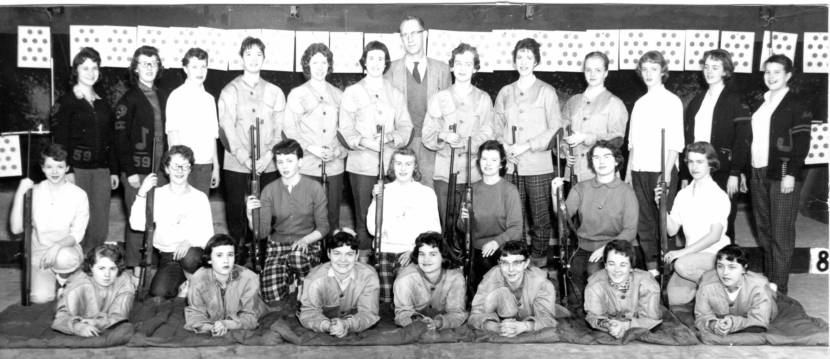
As part of KTOO’s Curious Juneau project, a listener asked: “Was there really a gun range in the basement of Harborview Elementary School?”
The short answer is yes. It was there for decades, and there are plenty of people still around in Juneau who remember it.
https://media.ktoo.org/wp-content/uploads/2021/08/05GunRange.mp3Flipping through decades of Juneau’s high school yearbooks, you’ll find some dated extracurriculars, like candy stripers and the Future Homemakers of America.
You’ll also find the rifle club, which was founded in 1934. Karleen Grummett is a former member.
“Rifle club was one of the more common groups to join in high school, and it sounded like fun to me,” she said. “They had both boys’ and girls’ rifle clubs, and they were both very well attended.”
Grummett participated in the club from 1958 until 1960, when she graduated from what was then Juneau High School (not yet Juneau-Douglas High School).
“It was just assumed that that’s where you went to learn how to shoot a rifle,” she said. “It was in the basement of the Harborview school.”
She joined the group hoping that if she could properly handle a gun, her father would take her hunting.
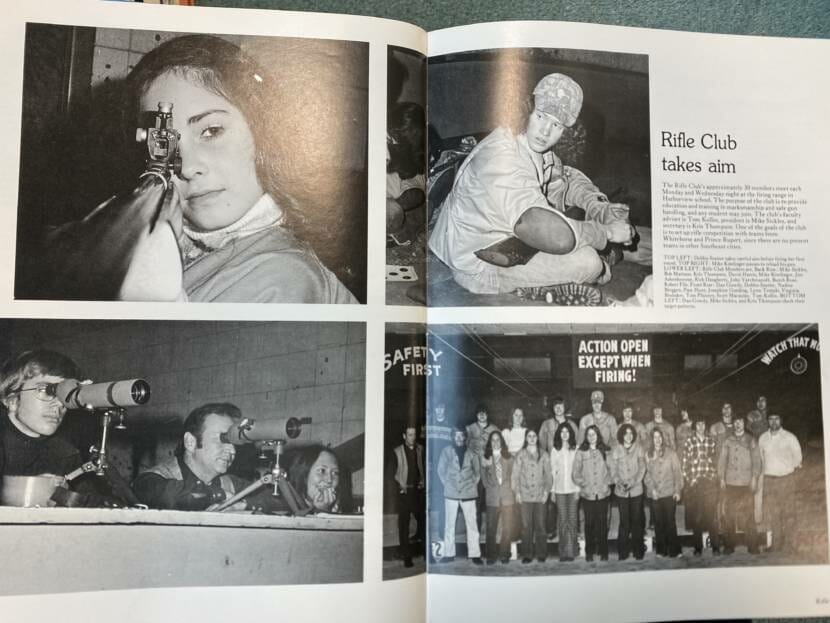
“That didn’t happen, but we still had a lot of fun,” Grummett said. “It was really noisy down there in that basement, with all the guns going off. I have nothing but fond memories of it.”
The girls would start in the prone position and work up to sitting, kneeling and standing.
“There were certain goals for each of those positions,” she said. “At the end of the year, you were awarded some brass bars that you put on a pin on your high school sweater.”
Club members could work their way up to “expert” or “distinguished” levels, and Grummett was proud to achieve the expert title.
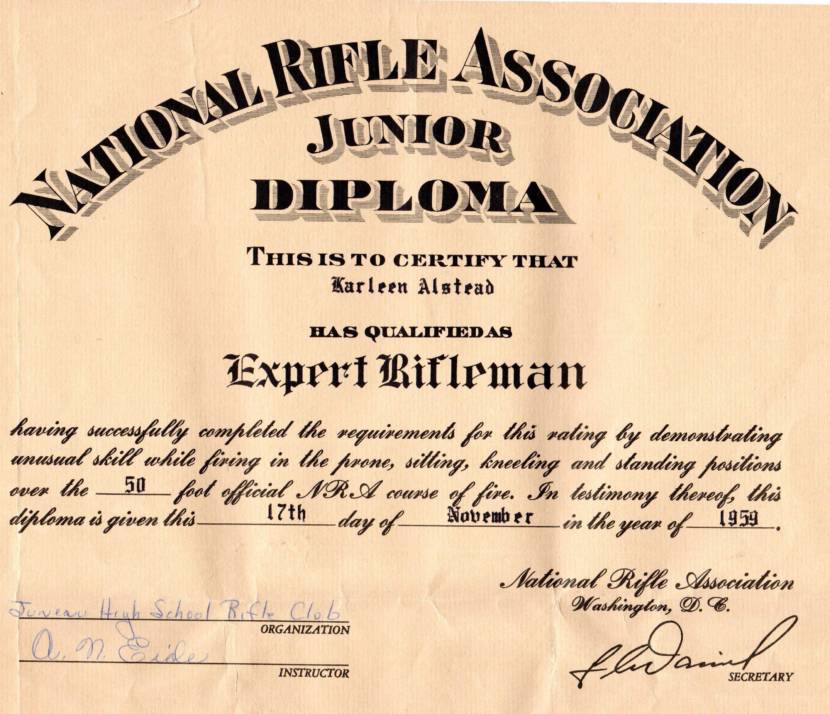
“But I was a little disappointed when I found out later that the way to get your ‘distinguished’ was to get special time at the gun range, and that wasn’t readily available to women at that time,” she said.
But the high school rifle club wasn’t the only organization to use the Harborview gun range. James Cartmill wasn’t yet 10 years old when he started taking gun safety classes through Territorial Sportsmen in the early 1970s.
“There was an open area down there [in the Harborview basement] right next to the rifle range that we would go in and play around until our names were called,” he said.
Courses were held for several weeks each year, and Cartmill’s family was heavily involved.
“My mom would be the one that would take down the names at the front door,” he said. “You would check in with her, and then they would have movies on shooting safety and hunting. My dad would run the movie projectors in the library area.”
At one point, Cartmill remembers there being about 50 kids involved in the program.
“There was, I believe, five different stations, and each one of the stations had a coach or an adult there to tell you how to use the gun, your breathing, your sight alignment, your trigger squeeze,” he said.
At the end of each day, the kids took their targets home to show off and later received certificates of completion. A few years later, in 1986, Ryan Scott took a hunter education class in the Harborview basement. Now he teaches the course through Alaska’s Department of Fish & Game, but a lot has changed since he first learned to shoot.
“Many of us, when we were older, especially in high school when we were able to drive, would hunt in the mornings before school started or in the afternoons as soon as it got done,” Scott said. “Certainly, I had shotguns in my vehicle because that’s what I was doing after school.”
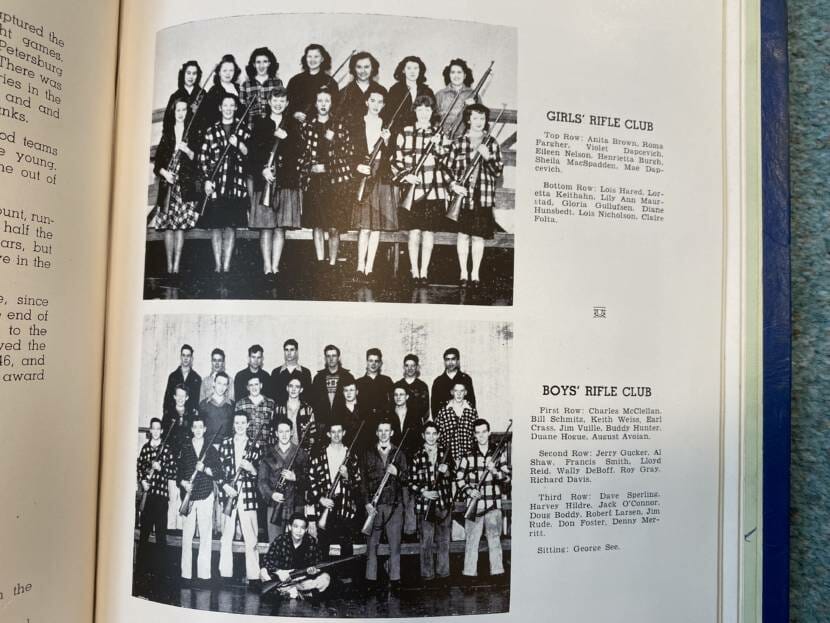
Nowadays, taking a gun to school would land you in a lot of trouble. Debates over American gun laws heated up over the years as mass shootings became more frequent.
Scott said his courses aren’t just for hunters, and being familiar with a gun could help dispel some of the fear people associate with them.
“That does give an individual more comfort, just understanding what the firearm really is and what it will do,” Scott said. “And then also knowing, well, this is the type of ammunition. You know, it’s not a shotgun shell, it’s a cartridge, and this is a revolver, this is a semi-automatic pistol, things like that.”
Scott said that education could come in handy even if you don’t have a gun in your home because it’s not uncommon to come across one in someone else’s, especially in Alaska.
Continuing through those high school yearbooks, the number of rifle club members gets much smaller in the late ’70s, then the club disappears completely.
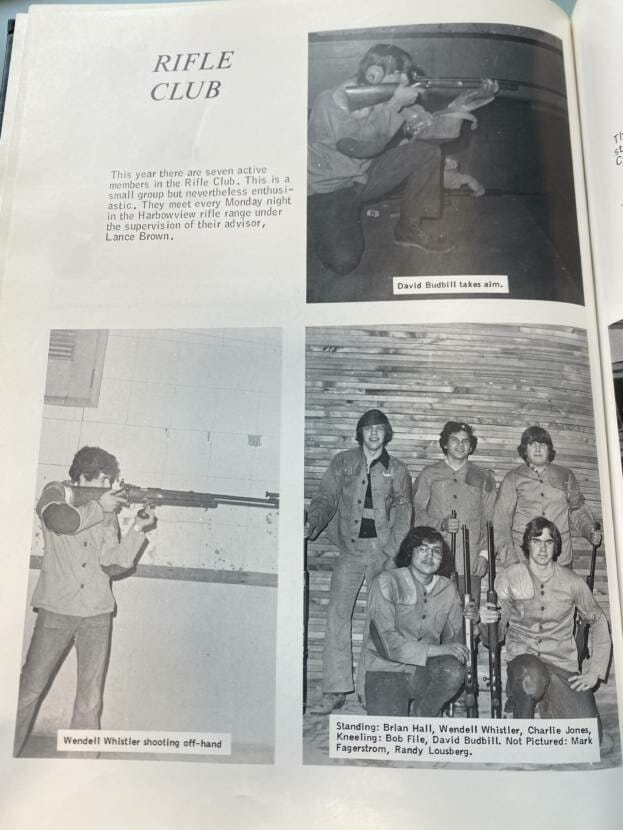
As for the rifle range at Harborview, it’s long gone. The school was renovated in the early 2000s and didn’t include a range. Around that time, a new gun range was built in Montana Creek.
But for James Cartmill, when it comes to gun safety, some things haven’t changed. He and his two grown children still go hunting, employing the lessons he learned in Harborview’s basement more than 40 years ago.
“You know, it’s not a toy, it’s a weapon,” he said. “That’s something that I’ve instilled in my kids.”
Are you curious about Juneau, its history, places and people? Or if you just like to ask questions, then ask away!
- What do you want to know about Juneau?
- Name*First Last
- Email*
- Phone
- Zip Code ZIP / Postal Code
20 episodes
Manage episode 299401364 series 1457379

As part of KTOO’s Curious Juneau project, a listener asked: “Was there really a gun range in the basement of Harborview Elementary School?”
The short answer is yes. It was there for decades, and there are plenty of people still around in Juneau who remember it.
https://media.ktoo.org/wp-content/uploads/2021/08/05GunRange.mp3Flipping through decades of Juneau’s high school yearbooks, you’ll find some dated extracurriculars, like candy stripers and the Future Homemakers of America.
You’ll also find the rifle club, which was founded in 1934. Karleen Grummett is a former member.
“Rifle club was one of the more common groups to join in high school, and it sounded like fun to me,” she said. “They had both boys’ and girls’ rifle clubs, and they were both very well attended.”
Grummett participated in the club from 1958 until 1960, when she graduated from what was then Juneau High School (not yet Juneau-Douglas High School).
“It was just assumed that that’s where you went to learn how to shoot a rifle,” she said. “It was in the basement of the Harborview school.”
She joined the group hoping that if she could properly handle a gun, her father would take her hunting.

“That didn’t happen, but we still had a lot of fun,” Grummett said. “It was really noisy down there in that basement, with all the guns going off. I have nothing but fond memories of it.”
The girls would start in the prone position and work up to sitting, kneeling and standing.
“There were certain goals for each of those positions,” she said. “At the end of the year, you were awarded some brass bars that you put on a pin on your high school sweater.”
Club members could work their way up to “expert” or “distinguished” levels, and Grummett was proud to achieve the expert title.

“But I was a little disappointed when I found out later that the way to get your ‘distinguished’ was to get special time at the gun range, and that wasn’t readily available to women at that time,” she said.
But the high school rifle club wasn’t the only organization to use the Harborview gun range. James Cartmill wasn’t yet 10 years old when he started taking gun safety classes through Territorial Sportsmen in the early 1970s.
“There was an open area down there [in the Harborview basement] right next to the rifle range that we would go in and play around until our names were called,” he said.
Courses were held for several weeks each year, and Cartmill’s family was heavily involved.
“My mom would be the one that would take down the names at the front door,” he said. “You would check in with her, and then they would have movies on shooting safety and hunting. My dad would run the movie projectors in the library area.”
At one point, Cartmill remembers there being about 50 kids involved in the program.
“There was, I believe, five different stations, and each one of the stations had a coach or an adult there to tell you how to use the gun, your breathing, your sight alignment, your trigger squeeze,” he said.
At the end of each day, the kids took their targets home to show off and later received certificates of completion. A few years later, in 1986, Ryan Scott took a hunter education class in the Harborview basement. Now he teaches the course through Alaska’s Department of Fish & Game, but a lot has changed since he first learned to shoot.
“Many of us, when we were older, especially in high school when we were able to drive, would hunt in the mornings before school started or in the afternoons as soon as it got done,” Scott said. “Certainly, I had shotguns in my vehicle because that’s what I was doing after school.”

Nowadays, taking a gun to school would land you in a lot of trouble. Debates over American gun laws heated up over the years as mass shootings became more frequent.
Scott said his courses aren’t just for hunters, and being familiar with a gun could help dispel some of the fear people associate with them.
“That does give an individual more comfort, just understanding what the firearm really is and what it will do,” Scott said. “And then also knowing, well, this is the type of ammunition. You know, it’s not a shotgun shell, it’s a cartridge, and this is a revolver, this is a semi-automatic pistol, things like that.”
Scott said that education could come in handy even if you don’t have a gun in your home because it’s not uncommon to come across one in someone else’s, especially in Alaska.
Continuing through those high school yearbooks, the number of rifle club members gets much smaller in the late ’70s, then the club disappears completely.

As for the rifle range at Harborview, it’s long gone. The school was renovated in the early 2000s and didn’t include a range. Around that time, a new gun range was built in Montana Creek.
But for James Cartmill, when it comes to gun safety, some things haven’t changed. He and his two grown children still go hunting, employing the lessons he learned in Harborview’s basement more than 40 years ago.
“You know, it’s not a toy, it’s a weapon,” he said. “That’s something that I’ve instilled in my kids.”
Are you curious about Juneau, its history, places and people? Or if you just like to ask questions, then ask away!
- What do you want to know about Juneau?
- Name*First Last
- Email*
- Phone
- Zip Code ZIP / Postal Code
20 episodes
All episodes
×Welcome to Player FM!
Player FM is scanning the web for high-quality podcasts for you to enjoy right now. It's the best podcast app and works on Android, iPhone, and the web. Signup to sync subscriptions across devices.




